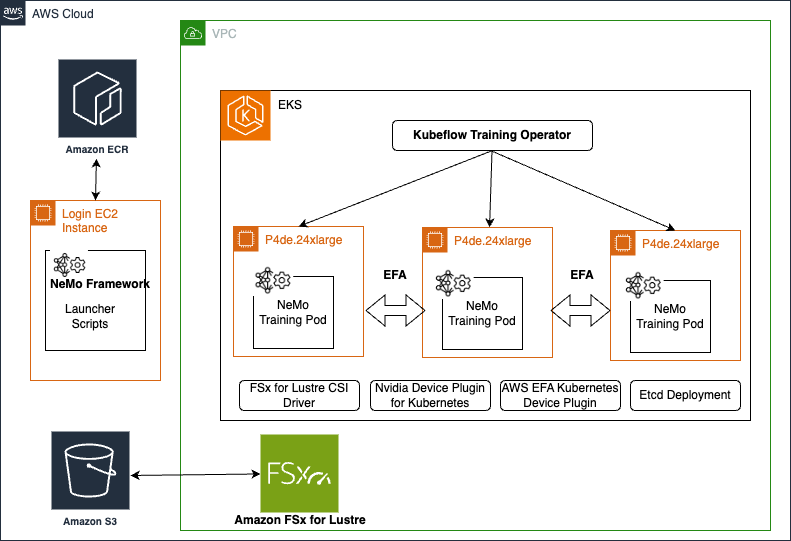Artificial Intelligence
Category: Amazon Elastic Kubernetes Service
Build scalable containerized RAG based generative AI applications in AWS using Amazon EKS with Amazon Bedrock
In this post, we demonstrate a solution using Amazon Elastic Kubernetes Service (EKS) with Amazon Bedrock to build scalable and containerized RAG solutions for your generative AI applications on AWS while bringing your unstructured user file data to Amazon Bedrock in a straightforward, fast, and secure way.
How Hexagon built an AI assistant using AWS generative AI services
Recognizing the transformative benefits of generative AI for enterprises, we at Hexagon’s Asset Lifecycle Intelligence division sought to enhance how users interact with our Enterprise Asset Management (EAM) products. Understanding these advantages, we partnered with AWS to embark on a journey to develop HxGN Alix, an AI-powered digital worker using AWS generative AI services. This blog post explores the strategy, development, and implementation of HxGN Alix, demonstrating how a tailored AI solution can drive efficiency and enhance user satisfaction.
Automate Amazon EKS troubleshooting using an Amazon Bedrock agentic workflow
In this post, we demonstrate how to orchestrate multiple Amazon Bedrock agents to create a sophisticated Amazon EKS troubleshooting system. By enabling collaboration between specialized agents—deriving insights from K8sGPT and performing actions through the ArgoCD framework—you can build a comprehensive automation that identifies, analyzes, and resolves cluster issues with minimal human intervention.
Optimizing AI implementation costs with Automat-it
In this guest post, we explain how AWS Partner Automat-it helped their customer achieve a more than twelvefold cost savings while keeping AI model performance within the required performance thresholds. This was accomplished through careful tuning of architecture, algorithm selection, and infrastructure management.
How Rocket Companies modernized their data science solution on AWS
In this post, we share how we modernized Rocket Companies’ data science solution on AWS to increase the speed to delivery from eight weeks to under one hour, improve operational stability and support by reducing incident tickets by over 99% in 18 months, power 10 million automated data science and AI decisions made daily, and provide a seamless data science development experience.
Building the future of construction analytics: CONXAI’s AI inference on Amazon EKS
CONXAI Technology GmbH is pioneering the development of an advanced AI platform for the Architecture, Engineering, and Construction (AEC) industry. In this post, we dive deep into how CONXAI hosts the state-of-the-art OneFormer segmentation model on AWS using Amazon Simple Storage Service (Amazon S3), Amazon Elastic Kubernetes Service (Amazon EKS), KServe, and NVIDIA Triton.
How Aetion is using generative AI and Amazon Bedrock to unlock hidden insights about patient populations
In this post, we review how Aetion’s Smart Subgroups Interpreter enables users to interact with Smart Subgroups using natural language queries. Powered by Amazon Bedrock and Anthropic’s Claude 3 large language models (LLMs), the interpreter responds to user questions expressed in conversational language about patient subgroups and provides insights to generate further hypotheses and evidence.
Deploy Meta Llama 3.1-8B on AWS Inferentia using Amazon EKS and vLLM
In this post, we walk through the steps to deploy the Meta Llama 3.1-8B model on Inferentia 2 instances using Amazon EKS. This solution combines the exceptional performance and cost-effectiveness of Inferentia 2 chips with the robust and flexible landscape of Amazon EKS. Inferentia 2 chips deliver high throughput and low latency inference, ideal for LLMs.
Introducing Amazon EKS support in Amazon SageMaker HyperPod
This post is designed for Kubernetes cluster administrators and ML scientists, providing an overview of the key features that SageMaker HyperPod introduces to facilitate large-scale model training on an EKS cluster.
Accelerate your generative AI distributed training workloads with the NVIDIA NeMo Framework on Amazon EKS
In today’s rapidly evolving landscape of artificial intelligence (AI), training large language models (LLMs) poses significant challenges. These models often require enormous computational resources and sophisticated infrastructure to handle the vast amounts of data and complex algorithms involved. Without a structured framework, the process can become prohibitively time-consuming, costly, and complex. Enterprises struggle with managing […]









